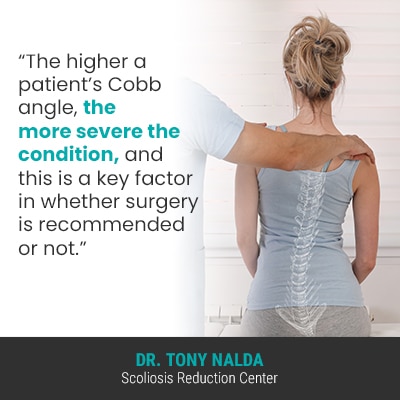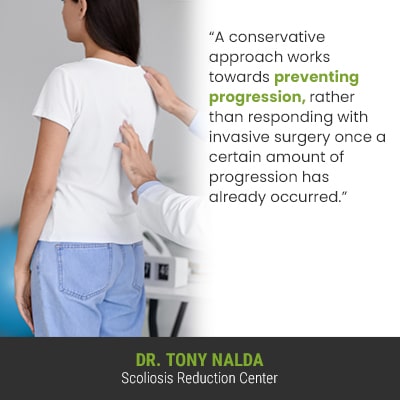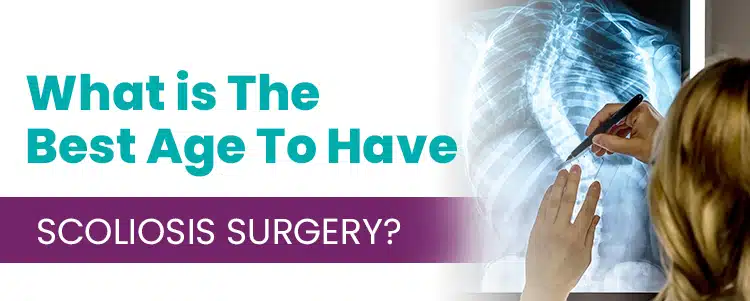It’s important to understand that just because scoliosis surgery was the dominant treatment option for many years, that doesn’t make it the best, or only way to treat scoliosis. In fact, many cases of scoliosis don’t require surgery, particularly those that are detected early and responded to with a proactive conservative treatment approach. Surgical recommendations are mainly based on condition severity and progression.
Each case of scoliosis is unique, and treatment options are based on a number of key patient/condition variables: treatment approach, patient age, skeletal maturity, condition severity, type, curvature location, and spinal flexibility all play a role in whether a surgical recommendation is given.
Determining the best age to have scoliosis surgery is based on a number of variables, so let’s first start with how scoliosis is diagnosed and classified.
Diagnosing and Classifying Scoliosis
Diagnosing and classifying scoliosis is based on a number of parameters and variables, and those same variables, plus the chosen treatment approach, all factor into whether a surgical recommendation is given.
In order to reach a diagnosis of scoliosis, certain parameters have to be met as there are a number of spinal conditions that involve a loss of its healthy curves.
Scoliosis is the development of an unnatural sideways spinal curve that also rotates, making it a 3-dimensional condition.
In addition to the scoliotic curve bending unnaturally to the side and also twisting from front to back, back to front, the curve has to be of a minimum size to be officially diagnosed as scoliosis: Cobb angle of at least 10 degrees.
A patient’s Cobb angle is determined during X-ray.
When the spine’s natural and healthy curves are in place, its vertebrae are aligned (stacked on top of one another in a straight and neutral alignment), but when an unnatural curve develops, the vertebral bodies at the apex of the curve are tilted, causing the spine to become misaligned.

The higher a patient’s Cobb angle, the more severe the condition, and this is a key factor in whether surgery is recommended or not.
Condition Severity and Scoliosis Surgery
For those on the path of traditional scoliosis treatment, condition severity provides a cutting-off point for spinal fusion recommendations.
The more severe a condition is, the more likely it is to continue progressing, and the more likely it is to progress to the point of crossing the surgical threshold:
- Mild scoliosis: Cobb angle measurement of between 10 and 25 degrees
- Moderate scoliosis: Cobb angle measurement of between 25 and 40 degrees
- Severe scoliosis: Cobb angle measurement of 40+ degrees
- Very-severe scoliosis: Cobb angle measurement of 80+ degrees
Scoliosis surgery is a type of spinal fusion that involves fusing the most-tilted vertebrae of the scoliotic curve into one solid bone, and this is done with the goal of eliminating movement (progression) in the area.
Rods are then attached to the spine with pedicle screws to hold it in place, and hardware attached is permanent.
If a patient is undergoing traditional treatment, there isn’t a strategy for treating scoliosis while mild, so watching and waiting is a common recommendation, at least until a condition becomes severe enough to warrant a surgical recommendation at a Cobb angle of 40+ degrees.
In addition, where a scoliosis is at the time of diagnosis does not guarantee that that’s where it will stay, at least not without proactive treatment that works towards counteracting the condition’s progressive nature.
Scoliosis is Progressive
Progression is another factor that affects surgical recommendations.
As a progressive condition, scoliosis has it in its nature to worsen over time, and the main goal of spinal fusion is not to correct a scoliosis, but to stop it from progression: two different goals that affect spinal health differently.
Scoliosis progressing means the size of the scoliotic curve is increasing, and this means the spine is becoming more rigid, less responsive to treatment, more complex to treat, and the condition’s uneven forces are increasing, as are their effects.
The main trigger for scoliosis progression is growth and development, so children are more at risk for rapid-phase progression than adults.
So for those on the path of traditional treatment, if a condition has progressed into the severe classification, with signs of continued progression, what age is best for scoliosis surgery?
What is the Best Age to Have Scoliosis Surgery?
For those opting for a surgical response to scoliosis, it can be difficult to know when is the best time to undergo spinal fusion.
The reality is that, like all surgical procedures, spinal fusion comes with its share of potential risks, side effects, and complications.
Spinal fusion is a costly, lengthy, and invasive procedure, and as is the case with all forms of scoliosis treatment, results can never be guaranteed.
Adolescent idiopathic scoliosis (AIS), diagnosed between the ages of 10 and 18, is the condition’s most-prevalent form, and while these patients are at risk for fast progression due to the unpredictable growth spurts that characterize puberty, their spines are still growing, so progression post surgery can’t be guaranteed.
Some of the risks associated with spinal fusion include:
- Nerve damage
- Excessive blood loss
- Infection
- Adverse reaction to hardware used
- Hardware malfunction
- Reduced range of motion and spinal flexibility
Studies have shown that the older a patient is, the more risky spinal fusion is, and if the surgery fails, the only recourse is more surgery, and those risks increase with each subsequent surgical procedure.
Adults over the age of 40 are facing natural age-related spinal degeneration, which makes their spines particularly vulnerable to injury and makes recovery and restoration less likely.
So when it comes to the best age to undergo scoliosis surgery, each case will be unique, but in general, the younger a patient is, the more resilient they tend to be, and the less likely those risky outcomes are; however, there are risks associated with spinal fusion at every age, so should be considered carefully.
For those who choose to forgo a surgical recommendation, the reality is that many cases of scoliosis don’t require surgery, and there is also a conservative non-surgical treatment approach with proven results to consider.
At What Age Can Scoliosis be Corrected Without Surgery?
The interesting thing about correcting scoliosis without surgery is that the earlier treatment is started in a condition’s progressive line, the more likely treatment success is, and as growth and development triggers progression, higher rates of treatment success are reached in young patients between the ages of 3 and 10.
So for those on the path of a conservative treatment approach, being proactive is key; treatment is started as close to the time of diagnosis as possible.
Here at the Scoliosis Reduction Center®, if a patient has mild scoliosis, this is the best time to start treatment: before the condition has progressed making the spine more rigid and less responsive to treatment, before the body has had time to adjust to the unnatural spinal curve’s presence, and before related complications have developed.
It’s far simpler to address scoliosis while mild, when condition effects are also going to be mild, than it is to work towards reversing those effects after they’ve developed and increased.

A conservative approach works towards preventing progression, rather than responding with invasive surgery once a certain amount of progression has already occurred.
In most cases, scoliosis can be corrected without surgery at any age, but treatment success is far more likely if significant progression hasn’t already occurred making the spine less responsive and more rigid so patients are less able to perform certain therapeutic exercises and stretches as part of treatment.
Conservative treatment combines multiple types of treatment so conditions can be impacted on every level.
Through condition-specific treatment that includes chiropractic care, physical therapy, corrective bracing, and rehabilitation, I can work towards adjusting the curve’s most-tilted vertebrae so the curve is reduced on a structural level (corrective results), increasing core strength so the spine is optimally supported by its surrounding muscles, pushing the spine into a corrective position, and prescribing a series of scoliosis-specific exercise and stretches to further stabilize the spine from home.
Conservative treatment wants to preserve as much of the spine’s natural strength, health, and function as possible, and one of its goals is to do so without surgery so patients don’t have to face the potential risks, side effects, and complications associated with spinal fusion.
Conclusion
There is no specific age that’s known as the best age to have scoliosis surgery because each case is as unique as the patient themselves.
Many variables factor into how treatment options are presented such as patient age, progression, condition type, severity, spinal flexibility, and curvature location.
For patients on the path of traditional treatment, surgery is more about severity and progression than it is about age, and if a patient becomes severe at 40+ degrees, this is when surgery is most often recommended.
Young adults tend to respond to spinal fusion better and heal faster than older adults for whom natural age-related spinal degeneration is a factor, and the younger a patient is, in many cases, the more resilient they are and the faster their spines are likely to heal.
Regardless of age, when it comes to progressive conditions like scoliosis, the best time to start scoliosis treatment is always now as conditions only get more complex to treat over time.
However, it’s important that patients understand there is another way to treat scoliosis, at any age, and that’s conservative chiropractic-centered treatment that offers patients a more natural, and less invasive, treatment option.




